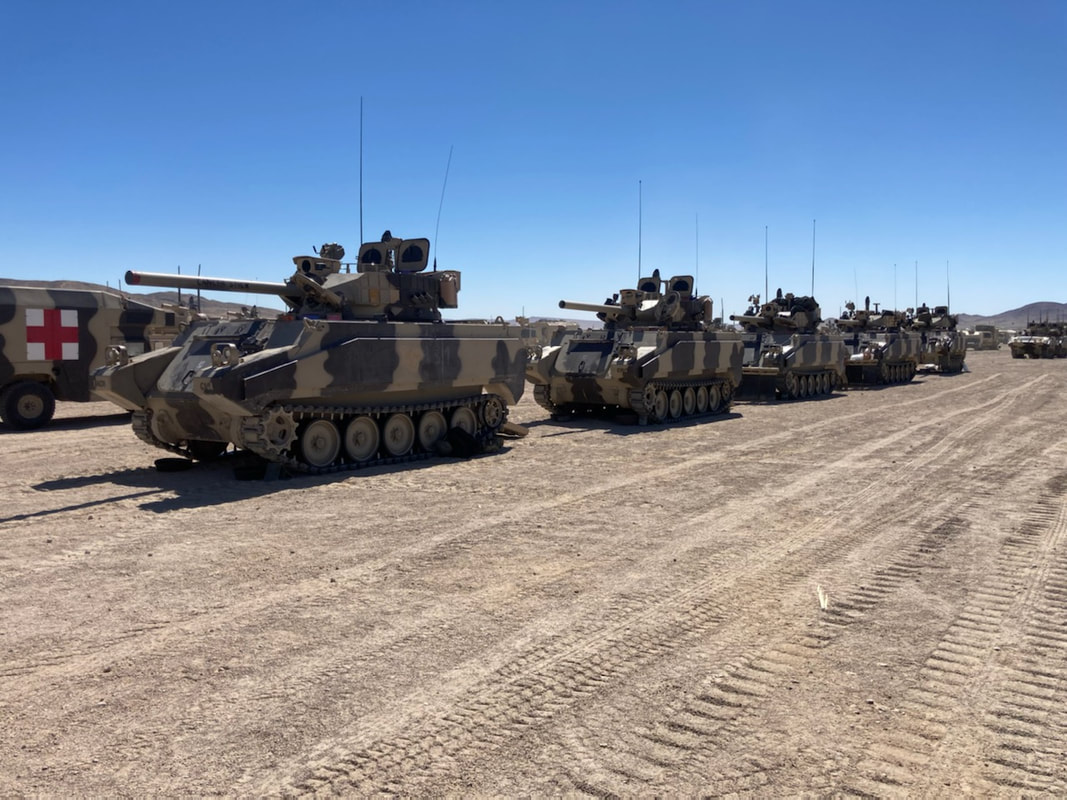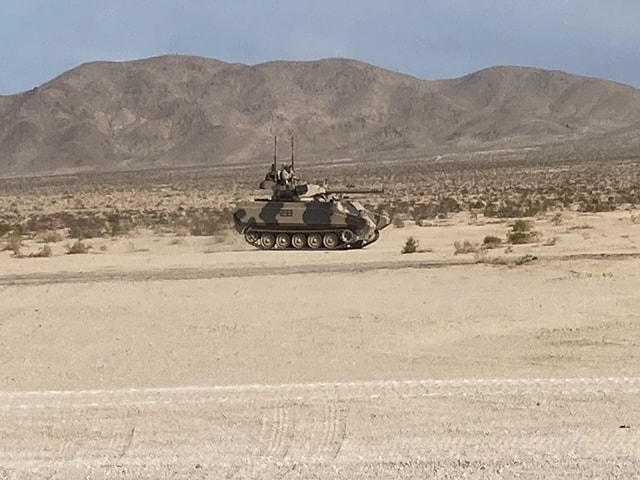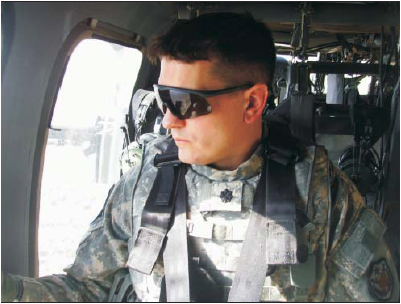|
Ruminations on Combined Arms Maneuver as I watch training battles in the Mojave Desert and read about real battles in Ukraine. I am writing this while I sit in a hotel room at Fort Irwin, California in the middle of the high-altitude Mojave Desert. I have had the privilege to regain an appreciation of the power and challenges of combined arms maneuver while I watch dedicated American soldiers fight each other with an expensive form of laser tag. I, like many others, have also been consuming information on what is happening in Ukraine as these simulated battles occur. Some of what I have heard from Ukraine includes the importance and value of infantry carried antitank weapons, the need to protect ground forces and civilians against attack from the air, and the ever present need to support and sustain combat forces for day after day fighting (what we often simply call logistics). Interestingly, these same imperatives or problems play out in the Mojave Desert. Logistics and maintenance matter, ground forces have to be protected against air attack, and anti-tank missiles are powerful killers of armored systems. None of these systems are crucial on their own. They matter most as part of a combination of the various types of capabilities present on a battlefield. This combination of a variety of forces with different strengths and weaknesses is what we call combined arms. It is an old concept. Alexander the Great combined his cavalry with the relentless advance of his infantry phalanx. As we learn when we read about Alexander, or any of the great commanders of the past, it isn’t about the capabilities as much as the timing of their use. What made the cavalry charge of Alexander so effective was its connection to opportunities created by the relentless effort of the heavy infantry. Timing, or synchronization, makes all the difference. An unsupported cavalry charge is just a slaughter of men and horses – see the charge of the Light Brigade from the Crimean War for such an example. The best armies combine the effects in time and space to create opportunities where each arm can then maximize the advantages they possess. Alexander’s infantry advance forced the enemy to use their shields against the sarissa (sixteen-foot-long spear) points which then opened the enemy up to arrows and sling bullets coming down from above. Adjustments to the line to compensate for fallen fighters created gaps in the line that allowed an opportunity for a rapid advance of the cavalry. This is the power of combined arms. A modern battlefield is this simplified version plus a lot more. The modern mounted force requires tens of thousands of gallons of fuel a day, repair parts, food and water, and ammunition. There are also attacks on communication networks, indirect fire that ranges tens of kilometers, and unmanned aerial vehicles (UAVs). All of these more recent capabilities add to the complexity of creating synchronization – a word that means to make things happen at the same time. Maybe not at the exact time, but in such a way as to create the benefits of the combined capabilities in near simultaneity. This explanation is offered to address a problem that is being expressed in assessments of the incomplete data coming out of the fighting in Ukraine. The problem is that the main battle tank is being made obsolete by individual shoulder fired anti-tank missiles. The Javelin missile has become quite a popular brand of these missiles in this current war. A similar thought was expressed in 1973 when Israeli tanks were stopped by AT-3 Sagger missiles carried by Egyptian infantry. The thought came back in 2020 as reports came out of the Nagorno-Karabakh fighting. On that occasion, the primary culprits were UAVs that dropped charges onto the top of tanks. As I watch battles at Fort Irwin, I also note that the anti-tank systems, whether mounted on a HUMMWV or carried by infantry, are also some of the biggest killers on the battlefield. Is the tank dead? No. In each of these examples predicting the death of the tank, the simple reason for anti-armor success was poor combined arms on the part of the side who lost all the tanks. This isn’t a defense of the tank. It is a weapon system that may no longer be as effective as it once was, but much as horse mounted cavalry was effective well past the introduction of gunpowder weapons, the tank still has a purpose on a modern battlefield. Again, I am not writing this to defend the tank. It is too heavy, drinks too much fuel, and requires too much support, but the immediate solution isn’t a better tank.
The solution is better combined arms. The best way to defeat infantry with anti-tank guided missiles is the use of mortars or other forms of indirect fire. The best way to defeat UAVs is with competent air defense. The infantry carried anti-tank missile is a combined arms solution to the problem of the tank. The protection of the tank requires a combined arms solution. Everyone knows this. Every competent military officer in every competent military (state and non-state) knows what I am saying is true. The challenge isn’t in the knowing, the challenge is in the doing. This is hard. It is hard to conceptualize. It is hard to manage. There is no such thing as multi-tasking. There is only task switching. A modern artillery officer thinks about artillery or indirect fire all the time when in combat. That officer is seeking to perform all of the needed tasks as efficiently and effectively as possible. It is unnatural for that officer to be thinking about the maneuver force, the enemy, the air defense systems, and logistics as well. This is why armies train: to make the soldier and officer into an unnatural performer of combined arms. George S. Patton Jr., of World War II fame, had an expression that he called the Musicians of Mars. He talked about this in an 8 July 1941 speech to the 2nd Armored Division included in The Patton Papers, Volume II. There is still a tendency in each separate unit…to be a one-handed puncher. By that I mean that the rifleman wants to shoot, the tanker to charge, the artilleryman to fire…That is not the way to win battles. If the band played a piece first with the piccolo, then with the brass horn, then with the clarinet, and then with the trumpet, there would be a hell of a lot of noise but no music. To get the harmony in music each instrument must support the others. To get harmony in battle, each weapon must support the other. Team play wins. You musicians of Mars must not wait for the band leader to signal you…You must each of your own volition see to it that you come into this concert at the proper place and at the proper time… What we seem to be seeing and hearing and reading about coming from Ukraine is that the Russian army is making a lot of noise, but not the music of synchronized and harmonious battle. There is no simple solution to this process, it must be trained. This brings me back to the Mojave Desert where US Army brigades come to train and learn how to become musicians and not just masters of an instrument. I have been having a running discussion and debate with the commander of the National Training Center (NTC) Opposing Force (OPFOR) about the word lethality. For him, the word is centralized on weapon system proficiency. For me the word implies individual, crew, and organizational effectiveness. He is probably right, but I am going to stick with my definition here as it applies to combined arms. A unit is not lethal if it cannot get its weapons systems to the fight to use its specific capabilities at the right time and place. That means that lethality includes maintenance, logistics, and the ability to administratively and tactically move. If any of those elements fail, then it doesn’t matter if the crew can effectively fire their weapon system or not. Lethality, then, as I think about it, is a form of crew or even individual level combined arms. To be ready and capable means that a person or small group of people must combine lots of things to be in the right place at the right time. Now we return to synchronization. Timing is everything. Just as is true with musicians, the artillery needs to suppress the enemy as maneuver forces advance, and then the artillery needs to shift its focus from fires to protection of the maneuver force once it is on the objective. Throughout the movement, the air defense system needs to protect against attack. Similarly, logistics need to be available in a protected environment as they are needed to allow the force to continue to move to the next objective assigned. This requires training opportunity after training opportunity. This is why the NTC OPFOR is the best combined arms force in the world. They get to execute a defense or attack four to six times a month and do so as part of a training rotation anywhere from six to ten times a year. That means a soldier, commander, or staff officer has an opportunity to think and do combined arms anywhere from 24 to 60 times a year. War is Darwinian. If you do not learn and adapt, then you die. What turns training into education is the thoughtful feedback, criticism, and reflection that allows a person and organization the opportunity to identify the correct adaptations. What should have been the right trigger? How fast or patient should I have been? Then it is exercised again. If you apply the lessons and thoughtful feedback properly then you are more proficient and you have learned. Then it is on to the next lesson. Adaptation takes time and opportunity and resources. NTC provides that, in brief for training units and over an expanse of time for the OPFOR. Before you believe any report coming out of Ukraine, recognize that the certain problem is bad combined arms maneuver and not a bad weapon system. The tank, as we know it, will eventually die, but that shouldn’t be as a result of inaccurate reporting about bad combined arms conducted by a poorly trained and educated army.
2 Comments
Scott Cunningham
22/3/2022 13:22:59
Great article. My only comment is its missing the key component of Combined Arms: Dilemma.
Reply
Brian L. Steed
22/3/2022 18:42:13
Excellent remarks. I agree with the importance of dilemma. Nice catch.
Reply
Leave a Reply. |
AuthorBrian L. Steed is an applied historian, Archives
February 2024
Categories |



 RSS Feed
RSS Feed